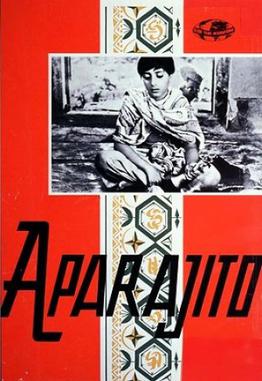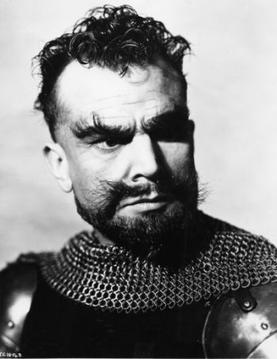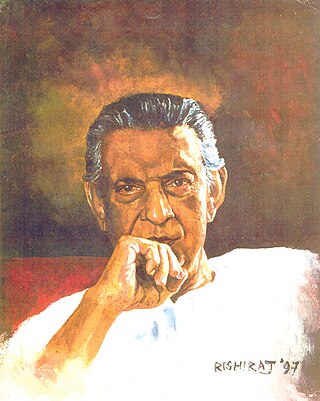
Jean Renoir was a French film director, screenwriter, actor, producer and author. As a film director and actor, he made more than forty films from the silent era to the end of the 1960s. His films La Grande Illusion (1937) and The Rules of the Game (1939) are often cited by critics as among the greatest films ever made. He was ranked by the BFI's Sight & Sound poll of critics in 2002 as the fourth greatest director of all time. Among numerous honours accrued during his lifetime, he received a Lifetime Achievement Academy Award in 1975 for his contribution to the motion picture industry. Renoir was the son of the painter Pierre-Auguste Renoir and the uncle of the cinematographer Claude Renoir. He was one of the first filmmakers to be known as an auteur.

The Apu Trilogy comprises three Indian Bengali-language drama films directed by Satyajit Ray: Pather Panchali (1955), Aparajito (1956) and The World of Apu (1959). The original music for the films was composed by Ravi Shankar.

Pather Panchali is a 1955 Indian Bengali-language drama film written and directed by Satyajit Ray in his directoral debut and produced by the Government of West Bengal. It is an adaptation of Bibhutibhushan Bandyopadhyay's 1929 Bengali novel of the same name and features Subir Banerjee, Kanu Banerjee, Karuna Banerjee, Uma Dasgupta, Pinaki Sengupta and Chunibala Devi in major roles. The first film in The Apu Trilogy, Pather Panchali depicts the childhood travails of the protagonist Apu and his elder sister Durga amidst the harsh village life of their poor family.

Aparajito is a 1956 Indian Bengali-language drama film written and directed by Satyajit Ray, and is the second part of The Apu Trilogy. It is adapted from the first half of Bibhutibhushan Bannerjee's novel Aparajito. It starts off where the previous film Pather Panchali (1955) ended, with Apu's family moving to Varanasi, and chronicles Apu's life from childhood to adolescence in college.

Esmond Penington Knight was an English actor. He had a successful stage and film career before World War II. For much of his later career Knight was half-blind. He had been badly wounded in 1941 while on active service on board HMS Prince of Wales when she fought the Bismarck at the Battle of the Denmark Strait, and remained totally blind for two years, though he later regained some sight in his right eye.

Mahanagar is a 1963 Indian Bengali-language drama film written and directed by Satyajit Ray. Starring Madhabi Mukherjee in the leading role and based on the short story Abataranika by Narendranath Mitra, it tells the story of a housewife who disconcerts her traditionalist family by getting the job of a saleswoman. The film marked the first screen appearance of Jaya Bhaduri, one of Hindi cinema's leading actresses.

Nayak is a 1966 Indian Bengali-language drama film composed, written, and directed by Satyajit Ray. It was Ray's second entirely original screenplay, after Kanchenjungha (1962). The story revolves around a matinee idol on a 24-hour train journey from Kolkata to Delhi to receive a national award. However, he ends up revealing his mistakes, insecurities and regrets to a young journalist, who realises that behind all his arrogant facade lies a deeply troubled man as his life's story is gradually revealed through seven flashbacks and two dreams. The film starring Uttam Kumar in main protagonist and Sharmila Tagore played second lead.

Abhijan is a 1962 Indian Bengali-language film directed by Satyajit Ray.

Satyajit Ray was an Indian filmmaker who worked prominently in Bengali cinema and who has often been regarded as one of the greatest directors of world cinema. Ray was born in Calcutta to a Bengali family and started his career as a junior visualiser. His meeting with French film director Jean Renoir, who had come to Calcutta in 1949 to shoot his film The River (1951), and his 1950 visit to London, where he saw Vittorio De Sica's Ladri di biciclette (1948), inspired Ray to become a film-maker. Ray made his directorial debut in 1955 with Pather Panchali and directed 36 films, comprising 29 feature films, five documentaries, and two short films.
Subrata Mitra was an Indian cinematographer. Acclaimed for his work in The Apu Trilogy (1955–1959), Mitra often is considered one of the greatest Indian cinematographers.
Bansi Chandragupta (1924–1981) was an Indian art director and production designer, regarded among the greatest of art directors of Indian film industry. He won Filmfare Best Art Direction Award thrice, for Seema in 1972, for Do Jhoot in 1976 and for Chakra in 1982. He was awarded Evening Standard British Film Award posthumously for "best technical/artistic achievement" in 1983. He was born in 1924 in Sialkot, Punjab, British India and died on 27 June 1981 in Brookhaven, New York, United States.

Vijaya Mulay was a documentary filmmaker, film historian, writer, educationist and researcher.
Parallel cinema or New Indian Cinema, is a film movement in Indian cinema that originated in the state of West Bengal in the 1950s as an alternative to the mainstream commercial Indian cinema.

Calcutta Film Society was India’s second film society in the city of Kolkata, West Bengal, India. It was founded in 1947, just after independence, by Satyajit Ray, Chidananda Dasgupta, RP Gupta, Bansi Chandragupta, Harisadhan Dasgupta and others. The 1925 silent film directed by Sergei Eisenstein, The Battleship Potemkin was the first film screened at the film society, which over the years developed the reputation of having the "most cine-literate audiences in the country". It was revived in 1956 with the efforts of stalwarts like Dasgupta, Vijaya Mulay, Diptendu Pramanick and Satyajit Ray.

Titash Ekti Nadir Naam, or A River Called Titas, is a 1973 Bangladeshi film directed by Ritwik Ghatak. The movie was based on a novel of the same name, by Adwaita Mallabarman. The movie explores the life of the fishermen on the bank of the Titas River in Brahmanbaria, Bangladesh.

Nagarik, also spelled as Nagorik, was the first feature-length film directed by legendary Indian director Ritwik Ghatak. Completed in 1952, it preceded Satyajit Ray's Pather Panchali as perhaps the first example of an art film in Bengali cinema, but is deprived of that honor, since it was released twenty-four years later, after Ghatak's death. On 20 September 1977, it finally premiered at the New Empire theatre in Kolkata, India. Ghatak directed only eight feature films, but is generally regarded as one of the auteurs of Indian cinema and virtually unsurpassed as a creator of powerful imagery and epic style by directors such as Satyajit Ray and of transcendental power and extraordinariness by critics such as Derek Malcolm.

Shatranj Ke Khilari, also subtitled and later internationally released with the translated title The Chess Players, is a 1977 Indian film written and directed by Satyajit Ray, based on Munshi Premchand's short story of the same name.

Satyajit Ray was an Indian director, screenwriter, documentary filmmaker, author, essayist, lyricist, magazine editor, illustrator, calligrapher, and composer. Ray is widely considered one of the greatest and most influential film directors in the history of cinema. He is celebrated for works including The Apu Trilogy (1955–1959), The Music Room (1958), The Big City (1963) and Charulata (1964) and the Goopy–Bagha trilogy.

Goopy Bagha Phirey Elo is a 1992 Indian Bengali comedy film directed by Sandip Ray and written by Satyajit Ray. A sequel to the 1980 film Hirak Rajar Deshe and the third installment of Goopy Gyne Bagha Byne series, the film was released twelve years after its predecessor. It was the third and last installment of the Goopy–Bagha series.
Marie Seton was a British actress, art, theatre and film critic and biographer of Sergei Eisenstein, Paul Robeson, Jawaharlal Nehru, and Satyajit Ray.
















